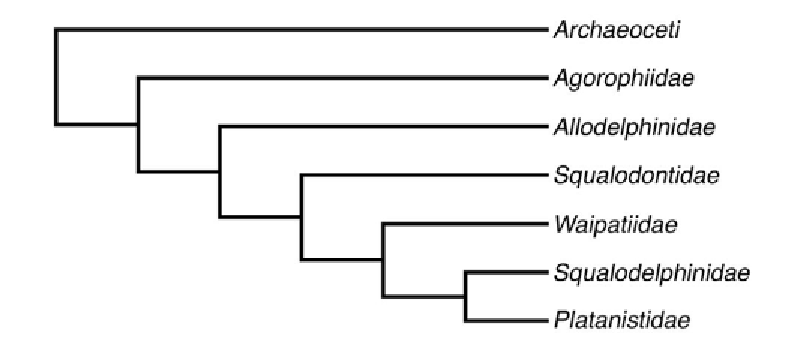Biology Reference
In-Depth Information
Figure 12.
Postulated phylogenetic relationships between more primitive Cetacea and the families of
the superfamily Platanistoidea: the Allodelphinidae, Squalodontidae, Waipatiidae, Squalodelphinidae,
and Platanistidae. Although time is not implied in this image, the early diversification among the four
extinct families of Platanistoidea, the Allodelphinidae, Squalodontidae, Waipatiidae, and
Squalodelpinidae, is implied, occurring during the later part of the Oligocene and the early part of the
Miocene. The platanistoids then gradually dwindled in diversity, so that only relict fresh water
populations of the genus
Platanista
(family Platanistidae) survive now. The evolutionary diversification
of the superfamily Platanistoidea has an inverse relationship with that of the superfamily Delphinoidea,
whose members were small, not taxonomically diverse, and rare in Late Oligocene time, then
diversified to become the most diverse group of living Cetacea (Modified from Barnes, 2006: Figure 9).
This analysis used 64 characters among nine taxa of fossil Cetacea, including some described members
of the superfamily Platanistoidea for which reasonably complete crania were available. The derived
Late Eocene archaeocete,
Zygorhiza kochii
(Reichenbach, 1847) from Alabama, U. S. A., was used to
root the tree, and the primitive odontocete,
Agorophius pygmaeus
(Müller, 1849) probably from South
Carolina, U. S. A., was used as the outgroup for the Platanistoidea. This was the only resulting tree,
having a tree length of 84, a Consistency Index of 0.76, a Retention Index of 0.75, and was obtained by
manipulating a character matrix with MacClade Version 3.01, and using the Branch and Bound search
option of PAUP Version 3.1.1.
S
UMMARY AND
C
ONCLUSIONS
1.
The superfamily Platanistoidea is a clade of Odontoceti that was diverse during
Oligocene and Miocene time, from approximately 30 to 10 or 12 million years ago.
The group subsequently declined in diversity, so that now within this superfamily
only the family Platanistidae survives, represented by the genus
Platanista,
living in
rivers of south Asia. Most fossil platanistoids were marine, but fossil members of the
family Platanistidae have been found in brackish and fresh water deposits as well as
marine deposits. The evolutionary history of the Platanistoidea has an inverse
relationship to the history of the superfamily Delphinoidea, which in the Oligocene
were small and rare, and today are the most diverse group of Cetacea.
2.
There are four extinct families within the Platanistoidea: the Allodelphinidae
(Miocene), Squalodontidae (Oligocene and Miocene), Waipatiidae (Oligocene and
Miocene), and Squalodelphinidae (Oligocene and Miocene). All fossils of these


Search WWH ::

Custom Search